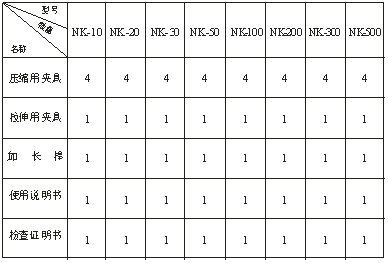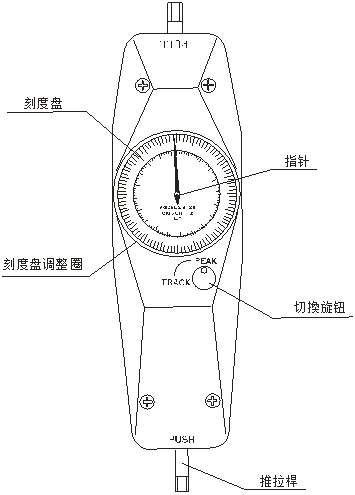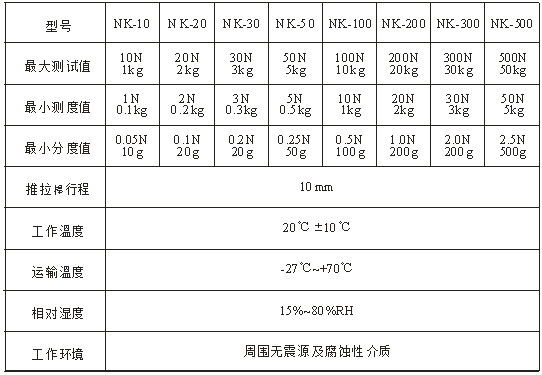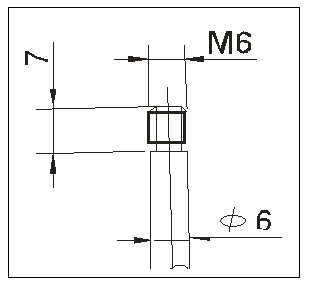I. Introduction
Nk series push-pull force meter is a small and portable tensile and pressure testing instrument. It has the advantages of high accuracy, easy operation, can display Newton and kilogram units at the same time, easy to carry, and has a peak load (PEAK) test and continuous load. The value (TRACK) test switch (PEAK / TRACK button) used to switch. Now widely used in electronics, high and low voltage electrical appliances, hardware locks, auto parts, viscose chemicals, lighters and ignition devices, pen making, light industry, construction, textile, machinery and other industries and scientific research institutions for tensile pressure load, insertion and extraction force Destructive test, etc., is an alternative to the old dynamometer. Please read this manual carefully before using the instrument, in order to make full use of the functions of the instrument, so that accurate values can be obtained during the test.
Details of random attachments

Third, the structure name

Fourth, appearance and installation dimensions

Five, specifications

Six, preparation before testing
Select the appropriate test fixture and install it on the push-pull gauge.
(1) Tensile test
Attach the stretching jig to the end marked PULL on the push-pull rod.
(2) Compression test
Attach the push jig to the end marked PUSH on the push-pull rod.
(3) Application of extension rod
When the fixture to be tested cannot be reached by pulling and pressing the fixture, please use an extension rod to install the fixture.
Note: During the test, the force to be tested and the push-pull rod of the push-pull force meter must be on the same straight line, otherwise the accurate load value cannot be measured.
(4) How to use the switch
(a) Peak load (PEAK)-the switching of continuous load (TRACK) will be switched: press the knob down and turn left at the same time, so that the\"\" ●\"mark of the knob stops at the continuous load (TRACK) ).
(b) Continuous load value (TRACK)-the switching of the peak load (PEAK) will be switched: the knob is turned to the right, and the knob pops up at this time, and the \"● \" mark of the knob stops at the position of the peak load (PEAK) .
(c) Cautions after test: After the test is completed, please place the\"\" ●\"mark of the switch knob on the position of the peak load (PEAK). If it is placed on the TRACK position for a long time. The service life of the internal return spring is shortened.
(5) Adjustment of the dial
(a) Check that the pointer is aligned with the (O) position on the dial. If it is not aligned, rotate the dial adjustment ring, the dials will move together to align the pointer with the (O) position.
(b) When the push-pull gauge is used in a vertical position, especially when a clamp is installed, the pointer will be tilted to one side even if no load is applied. This is due to the weight of the machine. Rotate the dial adjustment ring to align the (O) position of the dial with the fingers-this has no effect on the accuracy of the test results.
Note: If a load exceeding the maximum test range is often applied to the machine, the spring elasticity of the load detection mechanism will gradually deteriorate, and Daojia cannot detect the correct load value. When using, please be careful not to apply a load exceeding the maximum test range to maintain the life of the machine.
Test
(1) Hold the push-pull meter firmly or install the push-pull meter on a suitable test machine for testing. When testing, please make the tested force and the push-pull rod of the push-pull meter in a straight line so as to measure the accurate load value.

(2) Change of load during test
(a) When the switch is set to the continuous load value (TRACK), the pointer will move as the load changes.
(b) When the switching knob is set to the peak load (PEAK), when the test force reaches the maximum load, the pointer will stop at the position of the maximum load value, which is convenient for the user to read the data. To reset the pointer to zero, simply press the toggle knob.

Eight, homemade fixture
In order for the push-pull meter to measure accurately and stably
For the test value, make sure to make full use of the attached fixture. use
If you want to make a fixture suitable for testing, please refer to
The connection dimensions of the push-pull lever shown on the right.
Nine, care and maintenance
(1) Do not apply a load exceeding the maximum load of the push-pull meter to avoid damage to the instrument.
(2) Please keep and store it properly according to the regulations, and avoid storing or using the push-pull meter in places with low temperature, low humidity or high temperature, high humidity, and corrosive media, so as not to damage the instrument.
(3) Contact your dealer if a problem occurs.